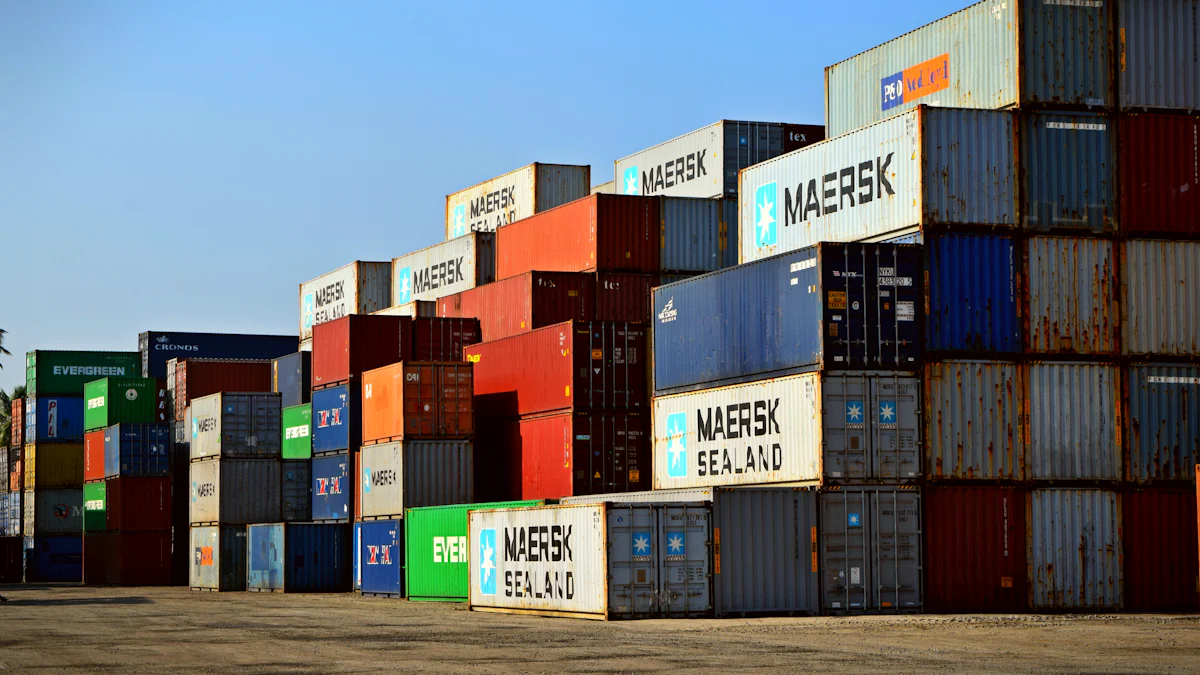5 Big Data Trends in the Logistics Industry

Big data analytics is revolutionizing the logistics industry by enabling smarter operations and better decision-making. You can now benefit from real-time insights, which streamline processes and reduce costs. With 98% of logistics providers relying on big data for decisions, its impact includes enhanced transparency, risk mitigation, and improved customer satisfaction through personalized services.
Key Takeaways
Live data helps track shipments and manage stock better.
Predictive tools show future needs, cutting costs and waste.
JUSDA's JusLink uses smart tech to make supply chains work well.
Predictive Analytics for Smarter Logistics Operations
Understanding Predictive Analytics in the Logistics Industry
Predictive analytics is transforming the logistics industry by enabling businesses to anticipate challenges and make proactive decisions. It uses big data analytics to analyze historical data and identify patterns, helping companies predict future outcomes with remarkable accuracy. This approach improves operational efficiency and reduces costs. For example, Amazon employs predictive analytics to forecast demand and optimize stock distribution, ensuring faster delivery. Similarly, Maersk Line uses it to enhance fleet efficiency and manage empty container relocation. These real-world applications highlight how predictive analytics drives smarter logistics operations.
Enhancing Demand Forecasting and Inventory Management
Accurate demand forecasting is critical for maintaining optimal inventory levels. Predictive analytics enables businesses to analyze data from multiple sources, such as sales trends and market conditions, to predict demand fluctuations. This insight minimizes overstocking and stockouts, leading to cost savings and improved customer satisfaction. Companies like Tyson Foods have successfully reduced waste and ensured timely product delivery by leveraging predictive analytics. Additionally, it transforms supply chains from guesswork-driven to insight-driven operations, smoothing out inefficiencies and reducing waste. By integrating predictive analytics, you can enhance decision-making and streamline inventory management.
JusLink’s Role in Predictive Analytics for Logistics
JusLink, JUSDA’s intelligent supply chain platform, leverages predictive analytics to revolutionize logistics operations. Its AI-driven sales forecasting tools analyze data with precision, enabling businesses to predict market trends and adjust inventory dynamically. JusLink’s Control Tower Intelligent Risk Management system integrates external data to monitor supply chain risks in real time, providing timely alerts to prevent disruptions. By offering end-to-end visibility and actionable insights, JusLink empowers you to optimize inventory, reduce risks, and improve overall efficiency. Its microservices architecture ensures seamless integration with existing systems, making it a versatile solution for modern supply chains.
Real-Time Data for Enhanced Supply Chain Visibility

The Importance of Real-Time Data in Logistics
Real-time data plays a crucial role in the logistics industry by providing transparency and improving decision-making. It allows you to track shipments and inventory levels accurately, ensuring that you always have up-to-date information. This level of visibility enhances operational efficiency and reduces risks. For example, stream processing enables faster shipping and receiving, which improves delivery times and customer satisfaction. IoT integration further strengthens monitoring by collecting data from sensors during transit. These advancements help you identify potential issues early, allowing for quick resolutions and better risk management.
Real-time data also improves transparency across the supply chain. Stakeholders can access accurate information about shipments, inventory, and delivery schedules. This reduces delays and ensures smoother operations. By adopting real-time processing, you can enhance your supply chain's velocity and volume handling, making it more agile and responsive to market demands.
Applications in Fleet Management and Delivery Optimization
Real-time data transforms fleet management by enabling instant route adjustments based on current conditions. You can reduce delivery times and fuel consumption by optimizing routes dynamically. Fleet managers can monitor vehicle locations and performance continuously, ensuring timely maintenance and minimizing downtime. For instance, real-time tracking allows you to respond quickly to disruptions like traffic or weather changes, keeping deliveries on schedule.
This data-driven approach also enhances delivery optimization. By analyzing real-time information, you can streamline operations, reduce wait times, and improve customer satisfaction. Companies that leverage real-time analytics often experience lower costs and higher efficiency, making their logistics operations more competitive.
How JUSDA Leverages Real-Time Data for Customer Satisfaction
JUSDA uses real-time data to deliver exceptional customer experiences. Its JusLink platform integrates IoT and big data analytics to provide end-to-end visibility across the supply chain. With real-time tracking, you can monitor shipments and inventory levels, ensuring timely deliveries. JusLink’s advanced analytics tools analyze data to optimize routes and reduce delays, improving operational efficiency.
JUSDA’s platform also enhances risk management by identifying potential disruptions early. For example, its Control Tower Intelligent Risk Management system uses real-time data to provide alerts, allowing you to address issues proactively. By leveraging these capabilities, JUSDA ensures that your logistics operations remain efficient and customer-focused.
IoT Integration and Big Data Analytics in Logistics

IoT’s Role in Data Collection and Analysis
IoT plays a vital role in collecting and analyzing data in the logistics industry. Sensors, RFID tags, and GPS devices gather real-time data from vehicles, cargo, and warehouses. This data enables you to monitor operations continuously and make informed decisions. For example, IoT devices track vehicle performance, helping you plan maintenance and extend vehicle lifespan. They also optimize route planning by analyzing fuel consumption and traffic patterns.
The benefits of IoT integration in logistics are numerous:
Benefit | Description |
|---|---|
Continuous monitoring of vehicle parameters helps in planning maintenance and predicting future needs. | |
Optimized route planning | Analyzing fuel consumption and routes leads to cost-effective delivery itineraries. |
Better cargo monitoring | Real-time updates on cargo conditions improve delivery quality and reduce costs. |
Improved driver management | Data on driver hours ensures safety and aids in payroll calculations. |
Improved Efficiency | Streamlined operations enhance asset management and delivery processes. |
Reduced Operational Costs | Real-time data helps in optimizing resource utilization and cutting costs. |
Enhanced Customer Satisfaction | Transparency and timely deliveries boost customer trust and reliability. |
By leveraging IoT, you can transform logistics operations into a data-driven ecosystem that enhances efficiency and customer satisfaction.
Applications in Asset Tracking and Predictive Maintenance
IoT revolutionizes asset tracking and predictive maintenance in logistics. You can use IoT sensors to monitor the location and condition of assets in real time. This ensures better visibility and reduces the risk of loss or damage. Predictive maintenance, powered by IoT, identifies potential equipment failures before they occur, saving costs and avoiding downtime.
Some successful examples include:
Eaton developed a system to predict hydraulic hose failures, improving asset visibility.
The railway sector uses IoT to track irregularities and prevent asset issues.
Mining operations save costs by preventing unexpected equipment failures.
Agricultural machinery benefits from IoT sensors that optimize operations.
These applications demonstrate how IoT enhances operational reliability and reduces risks in logistics.
Opportunities for IoT-Driven Logistics Solutions
IoT-driven solutions offer promising opportunities to improve logistics operations. Wireless devices like RFID tags and GPS sensors enhance supply chain efficiency and reduce transit times. AI algorithms, powered by IoT, assist in route management and improve security. End-to-end visibility through IoT allows you to track inventory and delivery status in real time.
Some of the most promising solutions include:
Real-time monitoring to increase operational efficiency.
GPS IoT devices for tracking rental equipment and maximizing utilization.
IoT solutions for containers and pallets to improve traceability and reduce loss.
Enhanced safety standards by identifying potential hazards.
Advanced predictive analytics to ensure regulatory compliance.
By adopting these solutions, you can stay ahead in the logistics industry and meet evolving customer demands effectively.
AI and Machine Learning Transforming Logistics Analytics
AI-Driven Decision-Making in the Logistics Industry
AI is revolutionizing decision-making in the logistics industry by enabling smarter and faster operations. It uses big data analytics to process vast amounts of data, providing actionable insights that improve efficiency. Predictive analytics helps you anticipate demand and optimize resources, ensuring better planning. Autonomous vehicles, including semi-autonomous technologies, enhance logistics efficiency by reducing delivery times and costs. AI-powered robots streamline warehouse operations, cutting labor costs and minimizing errors. Additionally, AI improves supply chain visibility, offering real-time tracking and operational transparency. These advancements make AI an essential tool for modern logistics operations.
Machine Learning for Route Optimization and Cost Reduction
Machine learning transforms route optimization by analyzing historical and real-time data to predict the best delivery routes. Advanced algorithms dynamically adjust routes based on traffic conditions, weather, and other factors. This approach reduces fuel consumption and delivery times, saving costs. Techniques like genetic algorithms simulate natural selection to find optimal solutions, while swarm intelligence mimics animal behavior to enhance routing. Reinforcement learning uses trial and error to refine decisions, ensuring continuous improvement. By adopting machine learning, you can achieve cost-effective and efficient logistics operations.
JusLink’s AI-Powered Tools for Supply Chain Efficiency
JusLink, JUSDA’s intelligent supply chain platform, leverages AI to enhance supply chain efficiency. Its AI-driven tools analyze big data to provide accurate sales forecasts and optimize inventory management. The platform’s Control Tower Intelligent Risk Management system monitors risks in real time, offering timely alerts to prevent disruptions. JusLink also uses machine learning to optimize delivery routes, reducing costs and improving delivery times. Its microservices architecture ensures seamless integration with your existing systems, making it a versatile solution for modern logistics challenges. By using JusLink, you can transform your supply chain into a data-driven, efficient ecosystem.
Blockchain for Data Security and Transparency in Logistics
Blockchain Technology and Its Applications in Logistics
Blockchain technology is transforming the logistics industry by enhancing transparency and efficiency. It creates a decentralized ledger that records every transaction, ensuring data remains secure and unalterable. This technology allows you to track shipments, verify product origins, and monitor cargo conditions in real time. By providing a single source of truth, blockchain reduces miscommunication and improves collaboration among stakeholders.
You can also benefit from faster customs clearance and automated processes. Blockchain eliminates the need for paperwork, speeding up transactions and lowering costs. Companies like DHL and Oracle have already adopted blockchain to enhance supply chain visibility and streamline operations. These applications demonstrate how blockchain simplifies logistics while improving accountability and trust.
Enhancing Trust and Fraud Prevention with Blockchain
Blockchain strengthens trust by ensuring data integrity. Once information is entered, it cannot be altered, making it impossible for bad actors to manipulate records. This feature helps you track product history and prevent counterfeit goods from entering the supply chain. Smart contracts further enhance security by automating transactions and ensuring compliance with agreed terms.
The decentralized nature of blockchain also reduces the risk of fraud. Information is shared across the network, making it nearly impossible to tamper with data. By adopting blockchain, you can improve transparency, reduce fraud, and build stronger relationships with customers and partners.
Blockchain ensures that once data is entered, it cannot be altered, making it impossible for bad actors to manipulate records or introduce false information. The immutable nature of blockchain makes it easier to track product history and prevent counterfeit goods from entering the supply chain.
JUSDA’s Approach to Blockchain-Enabled Supply Chain Solutions
JUSDA leverages blockchain to provide secure and transparent supply chain solutions. Its JusLink platform integrates blockchain technology to offer end-to-end visibility and real-time tracking. You can monitor shipments, verify product authenticity, and ensure compliance with regulations. JusLink also uses smart contracts to automate processes, reducing delays and improving efficiency.
By adopting blockchain, JUSDA enhances collaboration among supply chain participants. The platform’s immutable ledger ensures data accuracy, helping you mitigate risks and prevent fraud. With these capabilities, JUSDA empowers you to optimize your supply chain and deliver exceptional customer experiences.

JUSDA Solutions
To provide you with professional solutions and quotations.
Big data is reshaping logistics, offering transformative benefits across operations.
Key takeaways:
Real-time analytics optimize routes and schedules, boosting efficiency.
Enhanced visibility ensures effective inventory tracking and shipment monitoring.
Personalized services improve customer satisfaction with accurate delivery estimates.
Quick decision-making becomes possible with real-time data access.
Adopting these technologies is essential for staying competitive. Big data enhances customer satisfaction through tailored services and proactive communication. It also streamlines operations, addressing bottlenecks and maximizing resource utilization.
Benefit | Description |
|---|---|
Customer Satisfaction | Tailored services improve experiences and build trust. |
Cost Reduction | Optimized routes lower fuel and operational costs. |
Enhanced Decision-Making | Accurate data enables informed, efficient decisions. |
JUSDA leads this transformation with innovative solutions like JusLink, ensuring your logistics operations remain efficient and future-ready.
See Also
Five Key Trends Shaping Future Supply Chain Efficiency
Five Leading Logistics Programs You Need to Know in 2024
Understanding the Trends Affecting Logistics Risk Management
